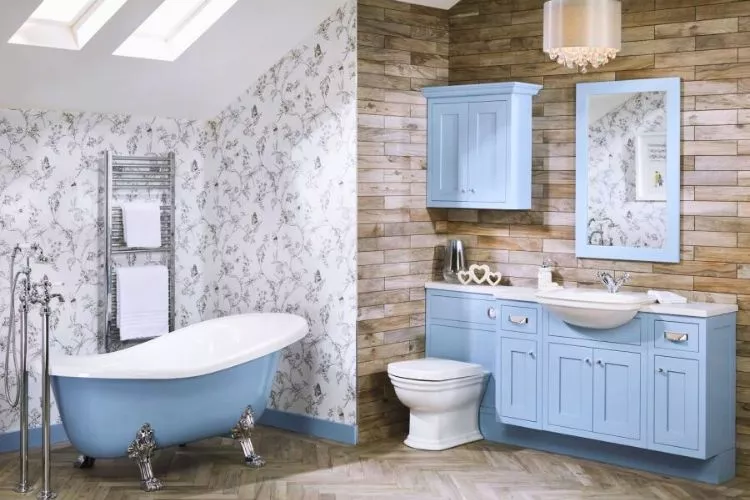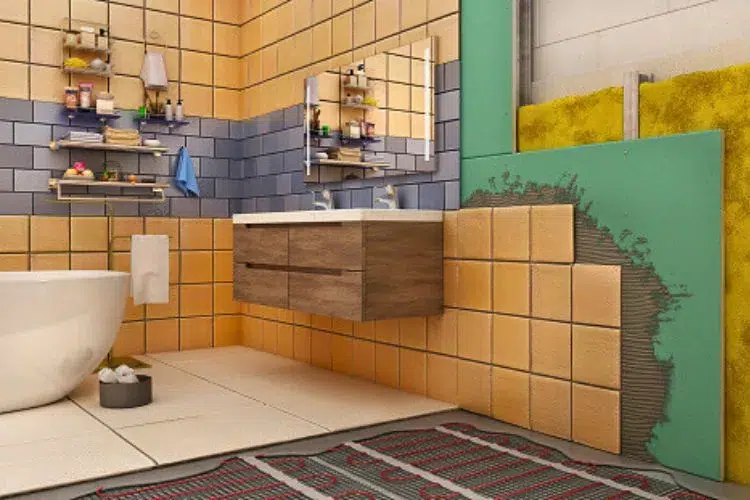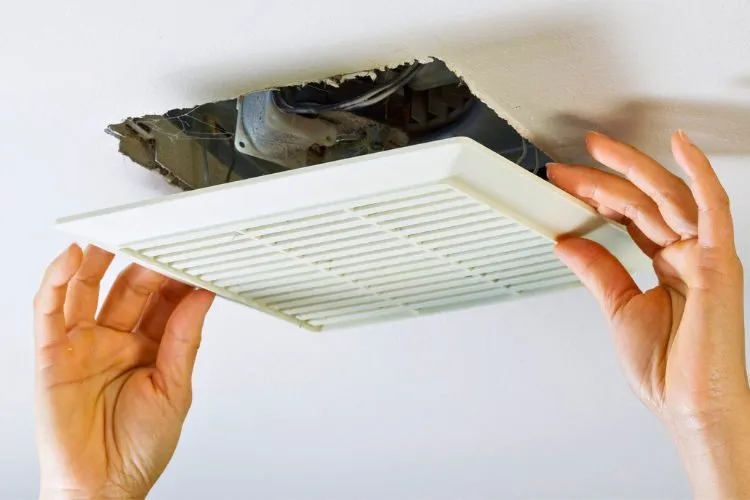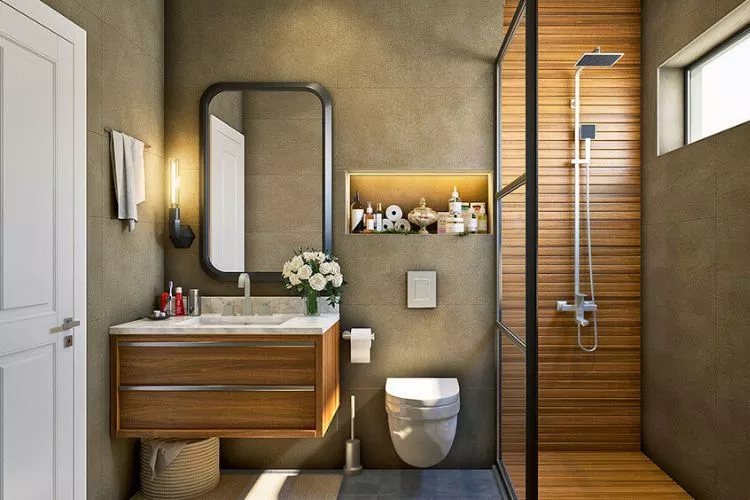Bathrooms often feel cold due to inadequate insulation, poor ventilation, and tile surfaces that retain less heat. These factors contribute to a chilly ambiance, as heat dissipates quickly and cold air seeps through gaps, windows, or doors. To improve warmth, consider adding insulation, sealing gaps, and using rugs or mats for heat retention.

Quick Recommendations
Last update on 2025-05-16 / Affiliate links / Images from Amazon Product Advertising API
Why is my bathroom so cold?
A cold bathroom can be uncomfortable, but several ways exist to address the issue. Adding insulation, improving ventilation, upgrading your heating system, and choosing warm materials can create a warm and inviting space for all your bathroom needs.
1. Lack of insulation
One common reason why bathrooms feel cold is the lack of insulation. Insulation is essential for retaining heat; without it, heat can quickly escape through walls and ceilings. Older homes, in particular, may have inadequate insulation, which can lead to cold bathrooms. Consider adding insulation to your bathroom walls, ceilings, and floors to address this issue. You can use various insulation materials, including fiberglass, cellulose, and foam.

2. Poor ventilation
Another reason why bathrooms can feel cold is poor ventilation. Inadequate ventilation can lead to moisture build-up, making your bathroom feel damp and chilly. Additionally, maintaining a consistent temperature can be challenging if your bathroom doesn’t have proper ventilation. To improve ventilation, consider installing a bathroom fan. A fan can help remove excess moisture and maintain a comfortable temperature in your bathroom.
3. Inefficient heating systems
The issue may be with your heating system if your bathroom is still cold, even with sufficient insulation and ventilation. Inefficient heating systems can struggle to maintain a comfortable temperature, leaving you shivering in your bathroom. Consider upgrading your heating system to a more efficient model or adding a supplemental heating source, such as a space heater or heated towel rack.

4. Cold surfaces and materials
Finally, cold surfaces and materials can contribute to a chilly bathroom. Tile, stone, and other hard surfaces tend to be cold to the touch, making your bathroom feel colder than it is. Consider adding rugs or mats to your bathroom floor to address this issue. You can also opt for warm and cozy materials, such as wood or cork, for your bathroom flooring or walls.
How do I stop my bathroom from being cold?
To prevent your bathroom from being cold, there are several solutions you can implement. By focusing on insulation options, ventilation improvement, upgrading heating systems, and changing surfaces and materials, you can create a warmer and more comfortable bathroom experience.
Insulation options
Insulating your bathroom is a crucial step to maintaining warmth. Some effective insulation options include:
- Wall insulation: Installing insulation in your bathroom walls can significantly reduce heat loss. Insulation materials such as fiberglass, cellulose, and foam can insulate walls.
- Floor insulation: Insulating your bathroom floor can also help retain heat. Consider using underfloor insulation materials like foam boards or insulated tile backer boards.
- Window insulation: Double or triple-glazed windows can help prevent heat loss and reduce drafts. Alternatively, you can apply window film to your existing windows to improve thermal performance.
Ventilation improvement
Improving ventilation can help maintain a consistent temperature while reducing moisture levels. Some ways to improve ventilation include:

- Installing an exhaust fan: An exhaust fan can remove excess moisture and help maintain a comfortable temperature.
- Ventilation grilles: Adding ventilation grilles to your bathroom door or walls can improve airflow and reduce dampness.
Upgrading heating systems
Upgrading your heating system can effectively warm your bathroom. Consider the following options:
- Radiant floor heating: Installing radiant floor heating can provide consistent warmth underfoot and evenly heat your bathroom.
- Heated towel racks can serve as a supplemental heating source and provide warm, cozy towels.
- Space heaters: A portable space heater can quickly warm up your bathroom, but remember to use it safely and follow the manufacturer’s guidelines.
Changing surfaces and materials
Altering the surfaces and materials in your bathroom can make a significant difference. Here are some suggestions:

- Flooring: Swap cold, hard materials like tiles for warmer options like vinyl, cork, or wood to create a warmer feel underfoot.
- Rugs and mats: Add rugs or mats to your bathroom floor to provide insulation and warmth.
- Wall coverings: Choose warm-toned colors and materials for your walls to create a more inviting atmosphere.
By focusing on these four areas—insulation, ventilation, heating systems, and surfaces—your bathroom will become more comfortable and welcoming.
You May Also Read: How To Protect Bathroom Floor From Urine? | Do Bathroom Fans Remove Smell?
frequently asked questions (fAQs)
u003cstrongu003eShould you heat a bathroom?u003c/strongu003e
Yes, it is recommended to heat a bathroom for comfort and to prevent issues like mold growth.
u003cstrongu003eWill a towel warmer heat a small bathroom?u003c/strongu003e
A towel warmer may not be enough to heat a small bathroom, but it can help add some warmth to the room.
u003cstrongu003eWhat kind of heater is safe to use in bathroom?u003c/strongu003e
A bathroom-safe electric heater recognized by a testing laboratory, such as a small and portable electric heater, is safe to use in a bathroom.
u003cstrongu003eDoes a hot shower warm up the bathroom?u003c/strongu003e
A hot shower can warm up a bathroom, but the heat will dissipate quickly after the shower is over. It is recommended to use a heater to maintain warmth in the bathroom.
u003cstrongu003eCan I put a heat lamp in my bathroom?u003c/strongu003e
A heat lamp can be installed in a bathroom, but it should be installed in a safe location away from water sources and connected to a GFCI outlet for safety.
Additional Strategies to Keep Your Bathroom Warm
Utilize Thermal Insulating Window Coverings
One often overlooked area for improving bathroom warmth is the windows. Windows can be a major source of heat loss, especially in colder climates.
By installing thermal insulating window coverings, such as heavy curtains or shades, you can significantly reduce the amount of heat escaping through the glass. These coverings trap air inside and keep the cold out, allowing the bathroom to retain more warmth.
Add a Bathroom Heater with a Timer
If you don’t want to leave your bathroom heater running all day, consider installing a heater with a timer. This can be particularly useful if you have a busy routine and want the bathroom to be warm when you need it most.
A timer can be set to turn on the heater a few minutes before you use the bathroom, ensuring that it’s warm and cozy without wasting energy.
Seal Gaps and Cracks
Even small gaps and cracks around doors, windows, and the edges of the floor can allow cold air to enter your bathroom. By sealing these gaps, you can prevent heat loss and maintain a more consistent temperature in the space.
Weather stripping around the door and window frames is an easy and effective way to keep cold air out. Use caulk for any visible cracks along walls and floorboards.
Use a Heated Toilet Seat
For added comfort, consider installing a heated toilet seat. This simple addition can make a noticeable difference, especially in colder weather. It provides a warm seat when you need it most, enhancing your bathroom experience and contributing to the overall warmth of the space.
Maintain Your Bathroom Heating System
Regular maintenance of your bathroom heating system is essential to ensure that it functions efficiently. Clean your heater or radiator regularly to prevent dust buildup, which can obstruct airflow and reduce heating effectiveness.
If you have underfloor heating, make sure the system is inspected periodically for any issues. Regular maintenance can prolong the lifespan of your heating system and keep your bathroom consistently warm.
Conclusion:
You can transform your bathroom into a warm and inviting space by addressing the issues through insulation improvements, upgraded heating systems, enhanced ventilation, and warmer material selections.
Taking these steps will provide comfort and help prevent potential problems like mold growth, ensuring a pleasant and healthy bathroom environment. If you were wondering why is my bathroom so cold, I hope I have been able to clear your confusion.





